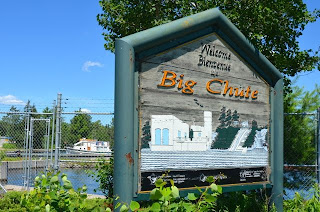Carrie Rose started rolling in the beam sea coming off of Lake Ontario. Actually rolling is too sedate of a word to describe the hurly-burly. I sped up hoping to calm the motion and reached for my bottle of Motion eaze as we entered the harbor area. These congested zones represent a challenge. Many times we arrive after cruising in isolation and then suddenly we are amongst all types of craft, many of which are exhibiting poor seamanship.
It calls for situational awareness, so I get off the bench and stand at the wheel. I begin to scan both visually and with radar. Radar helps alert me to other craft I might have overlooked. If I have the time I can also use it to take a bearing on the boat to see if we are on a collision course.
Charlotte is busy using the binoculars to pick out landmarks that may help guide us in to the marina. We also have to call, on the radio to the marina for a slip assignment. Kingston is squirrelly about this basic task. We usually have the marina’s system figured out, if not a reservation, before we get to our destination but here no definite answer about the availability of slips or where we should go to inquire was forthcoming. As you may imagine this only added to the stress.
On the way in we dodged speeding powerboats, parasailors, the upwind leg of a sailboat race and other cruising boats. Mercifully the large car ferry and multiple tour boats made there way out of the harbor just before we arrived. I turned to enter the marina still unsure of what I would do when I got there. The seas calmed down but not the wind. It was wickedly blowing across our path. This prevented me from just stopping Carrie Rose until we could come up with a plan.
Sir Tugley Blue was in front of us driving into what looked like a dead end and then she started to do maneuvers. I tried to contact them but they obviously had their hands full, so I made a couple of 360’s. Then I noticed they were waving us around the corner of where they had docked. It did not look good to me but trusting their judgment I took Carrie Rose in slowly.
Once there I saw the pier. Now remember Carrie Rose is 32 feet and this pier must have been ten feet shorter. I looked on incredulously but in front of me were four or five people willing to help us in, so in we went. A minute later we were hanging on the pier and I was rushing around tying lines in all kinds of funny ways to keep us in place.
It worked. Most of the fellow cruisers that helped us in were French Canadians. After we were settled, several of them quietly whispered in my ear that I had a beautiful boat. A sentiment I hardily agree with!

Before sunrise in Picton, ON

The view with breakfast from our mooring at Picton, ON

The squall that chased us out

Tumultuous skies

Things to avoid

I don't know what to say!














































